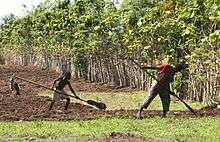Kajandu

The lower part of a kayendo ends in a sharp wrought iron blade.

The tool in use, tilling a rice field
Kajandu (also written kayendo, kajendo, kadiendo, or kadiandou) is a long-handled fulcrum shovel used by the Jola (Diola) people of Senegal, Gambia, and Guinea-Bissau to till and prepare rice paddy fields. It is also used to make dikes and furrows. It consists of a long wooden shaft, 1.6–3.5 metres long, and a large flat or concave wooden blade with iron edges. The long shaft rests on the knee and is used to lift up pieces of earth. Typically men use the kajandu while women sow, replant, spread manure and harvest.[1][2][3]
Use of the Kajandu was recorded in 1455[1] and was described in detail in 1685 by Sieur de la Courbe.[4] It is similar to the kop or cop used by the Baga people.[3]
See also
References
- 1 2 Carney, Judith Ann (2001). Black rice: the African origins of rice cultivation in the Americas. Harvard University Press. pp. 19,27–28,55–56,65–66. ISBN 0-674-00834-0. Retrieved 2009-11-21.
- ↑ Nyerges, A. Endre (1997). The ecology of practice: studies of food crop production in Sub-Saharan West Africa. Routledge. pp. 48,56–59. ISBN 90-5699-573-1. Retrieved 2009-11-21.
- 1 2 Sarró, Ramon (2009). The Politics of Religious Change on the Upper Guinea Coast: Iconoclasm Done and Undone. Edinburgh University Press. p. 26. ISBN 0-7486-3515-7. Retrieved 2009-11-21.
- ↑ Linares, Olga F. (December 2, 2002). "African rice (Oryza glaberrima): History and future potential". Proceedings of the National Academy of Sciences. 99 (25): 16360–16365. doi:10.1073/pnas.252604599. Retrieved 2009-11-21.
External links
- Picture from Linares 2002.
This article is issued from Wikipedia - version of the 10/15/2016. The text is available under the Creative Commons Attribution/Share Alike but additional terms may apply for the media files.